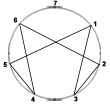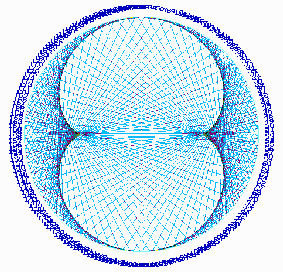HOW DOES IT WORK ?
The circle, the line and the
point, in combination with the numbers of additions, multiplications or
divisions invite us to fabulous discoveries.
EXAMPLE : THE
MULTIPLICATION BY 3 IN NUMBER 7
For example, we study the multiplication
by 3 by means of the progression of the triples: 1, 3, 9, 27, etc.,
and we draw it on the circumference of a circle defining N = 7
equidistant points numbered from 1 to N. Then we simply join the defined
points by drawing lines according to the order of the value of the terms
of the series.
Of course the progression of triples wich is theoretically infinite,
is here limited by the number of elements of N. Therefore, when the
value of a term of the series is higher than the value of N, we subtract
the value of N from the value of the term as many times as necessary.
In the same manner we count the hours, the 26th hour being equivalent
to 2 hours. In arithmetic, the terms are said to be congruent to the
number N. The progression 1, 3, 9, 27, etc., is thus transformed
into a periodic sequence with 6 terms: 1, 3, 2, 6, 4, 5, 1, etc. (9=9-7=2).

ex 1: the multiplication by 3 in a circle with 7 points
To represent
the multiplication by 3, we join every number to its triple on a
circle divided into N points.
Within the circle we draw a line from the point 1 to the point 3,
then another one from 3 to 2, another from 2 to 6, etc.:
1 * 3 = 3; a line joins 1 to 3
2 * 3 = 6; a line joins 2 to 6
3 * 3 = 9; a line joins 3 to 2 (because 9 - 7 = 2 in a circle with
7 points)
Did you understand
?
 ex. 2: multipl. by
3 in a circle with 211 points
ex. 2: multipl. by
3 in a circle with 211 points
Using a larger number
of elements on the circle, we'll obtain a better graphic definition
(ex.2, multiplication by 3 in a circle with 211 points). We observe
that all the straight lines are tangent to a 8-shaped curve named
nephroïde.
|